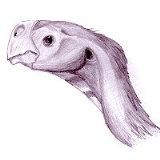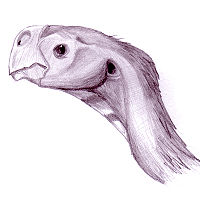
Conchoraptor
Encyclopedia
Conchoraptor is a genus
of oviraptorid
dinosaur
from the late Cretaceous
Period of what is now Asia
.
 Conchoraptor was a small dinosaur, only 1–2 meters (4–6 feet) in length. Unlike many other oviraptorids, Conchoraptor lacked a head crest. Like its relatives, it lacked teeth. Instead of teeth, oviraptorids had powerful beaks, possibly adapted to crushing mollusk shells. The skull of Conchoraptor was heavily pneumatised, with most of the bones hollow. Internal connections between both ears functioned as resonance chambers and improved hearing.
Conchoraptor was a small dinosaur, only 1–2 meters (4–6 feet) in length. Unlike many other oviraptorids, Conchoraptor lacked a head crest. Like its relatives, it lacked teeth. Instead of teeth, oviraptorids had powerful beaks, possibly adapted to crushing mollusk shells. The skull of Conchoraptor was heavily pneumatised, with most of the bones hollow. Internal connections between both ears functioned as resonance chambers and improved hearing.
of the Late Campanian
Nemegt Formation
by a Polish-Mongolian expedition in 1971, scientists believed that Conchoraptor was a juvenile Oviraptor
and that the animal's missing crest would have begun to grow when the animal reaching sexual maturity
. Further study of multiple skeletons showed that Conchoraptor belonged in a new genus. The hands of Conchoraptor were a major reason that scientists decided to split it off from Oviraptor. Anatomically the hands seemed to be an evolution
ary intermediate between those of "Ingenia
" and Oviraptor, making it obvious that this animal was not a member of a known species.
The type species
of this new genus, Conchoraptor gracilis, was described and named by Barsbold, in 1986. The generic name is derived from Greek konkhè, "mussel", and Latin
raptor, "plunderer". This name reflects Barsbold's hypothesis that oviraptorids, rather than preying primarily upon eggs as had been traditionally thought, may have been specialized to feed on mollusks. The specific name means "gracile" in Latin. The holotype
is IGM 100/20, a partial skeleton with skull. Later about two dozen specimens were formally referred to the species.
in 1986. Recent analyses show it was a member of the oviraptorid subfamily Ingeniinae.
Genus
In biology, a genus is a low-level taxonomic rank used in the biological classification of living and fossil organisms, which is an example of definition by genus and differentia...
of oviraptorid
Oviraptorosauria
Oviraptorosaurs are a group of feathered maniraptoran dinosaurs from the Cretaceous Period of what are now Asia and North America. They are distinct for their characteristically short, beaked, parrot - like skulls, with or without bony crests atop the head...
dinosaur
Dinosaur
Dinosaurs are a diverse group of animals of the clade and superorder Dinosauria. They were the dominant terrestrial vertebrates for over 160 million years, from the late Triassic period until the end of the Cretaceous , when the Cretaceous–Paleogene extinction event led to the extinction of...
from the late Cretaceous
Cretaceous
The Cretaceous , derived from the Latin "creta" , usually abbreviated K for its German translation Kreide , is a geologic period and system from circa to million years ago. In the geologic timescale, the Cretaceous follows the Jurassic period and is followed by the Paleogene period of the...
Period of what is now Asia
Asia
Asia is the world's largest and most populous continent, located primarily in the eastern and northern hemispheres. It covers 8.7% of the Earth's total surface area and with approximately 3.879 billion people, it hosts 60% of the world's current human population...
.
Description

Discovery
When first discovered in the Red Beds of Hermiin TsavRed Beds of Hermiin Tsav
The Red Beds of Hermiin Tsav is a geological formation in Mongolia whose strata date back to the Late Cretaceous. Dinosaur remains are among the fossils that have been recovered from the formation.-References:...
of the Late Campanian
Campanian
The Campanian is, in the ICS' geologic timescale, the fifth of six ages of the Late Cretaceous epoch . The Campanian spans the time from 83.5 ± 0.7 Ma to 70.6 ± 0.6 Ma ...
Nemegt Formation
Nemegt Formation
The Nemegt Formation is a geological formation dating from the Late Cretaceous sedimentary from the Gobi Desert of Mongolia. It overlies and sometimes forms folds with the Barun Goyot Formation. It consists of river channel sediments and contains fossils of fish, turtles, crocodilians, birds and a...
by a Polish-Mongolian expedition in 1971, scientists believed that Conchoraptor was a juvenile Oviraptor
Oviraptor
Oviraptor is a genus of small Mongolian theropod dinosaur, first discovered by the paleontologist Roy Chapman Andrews, and first described by Henry Fairfield Osborn, in 1924...
and that the animal's missing crest would have begun to grow when the animal reaching sexual maturity
Sexual maturity
Sexual maturity is the age or stage when an organism can reproduce. It is sometimes considered synonymous with adulthood, though the two are distinct...
. Further study of multiple skeletons showed that Conchoraptor belonged in a new genus. The hands of Conchoraptor were a major reason that scientists decided to split it off from Oviraptor. Anatomically the hands seemed to be an evolution
Evolution
Evolution is any change across successive generations in the heritable characteristics of biological populations. Evolutionary processes give rise to diversity at every level of biological organisation, including species, individual organisms and molecules such as DNA and proteins.Life on Earth...
ary intermediate between those of "Ingenia
Ingenia
"Ingenia" is a genus of oviraptorid theropod dinosaurs, with one known species, "Ingenia" yanshini. Fossils have been found in several Late Cretaceous-age formations of Mongolia, most prominently in the Bugin Tsav beds of the Nemegt Formation, which has also yielded the holotype of Mononykus...
" and Oviraptor, making it obvious that this animal was not a member of a known species.
The type species
Type species
In biological nomenclature, a type species is both a concept and a practical system which is used in the classification and nomenclature of animals and plants. The value of a "type species" lies in the fact that it makes clear what is meant by a particular genus name. A type species is the species...
of this new genus, Conchoraptor gracilis, was described and named by Barsbold, in 1986. The generic name is derived from Greek konkhè, "mussel", and Latin
Latin
Latin is an Italic language originally spoken in Latium and Ancient Rome. It, along with most European languages, is a descendant of the ancient Proto-Indo-European language. Although it is considered a dead language, a number of scholars and members of the Christian clergy speak it fluently, and...
raptor, "plunderer". This name reflects Barsbold's hypothesis that oviraptorids, rather than preying primarily upon eggs as had been traditionally thought, may have been specialized to feed on mollusks. The specific name means "gracile" in Latin. The holotype
Holotype
A holotype is a single physical example of an organism, known to have been used when the species was formally described. It is either the single such physical example or one of several such, but explicitly designated as the holotype...
is IGM 100/20, a partial skeleton with skull. Later about two dozen specimens were formally referred to the species.
Classification
Conchoraptor was by Barsbold assigned to the OviraptoridaeOviraptoridae
Oviraptoridae is a group of bird-like, herbivorous and omnivorous maniraptoran dinosaurs. Oviraptorids are characterized by their toothless, parrot-like beaks and, in some cases, elaborate crests. They were generally small, measuring between one and two metres long in most cases, though some...
in 1986. Recent analyses show it was a member of the oviraptorid subfamily Ingeniinae.

